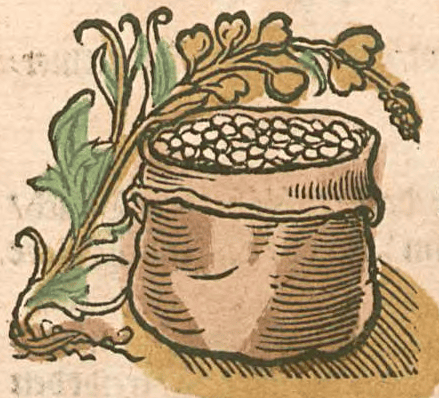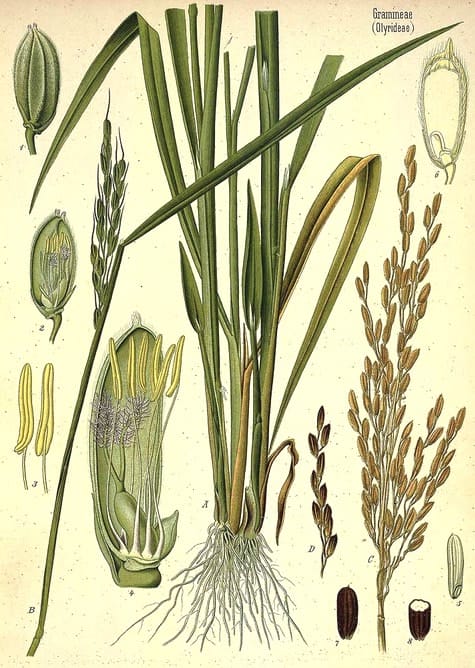Oryza, Rice, Mi 米
Mi (TCM) Krauterbuch, Lonitzer, 1578
Krauterbuch, Lonitzer, 1578 Koehler, Medizinal Pflanzen, 1890
Koehler, Medizinal Pflanzen, 1890Botanical name:
Oryza sativa
Parts used:
Seed (grain); Germinated Rice
Temperature & Taste:
Brown Rice: Warm, dry, astringent, sweet; heavy
White and Basmati Rice: Neutral; dry, astringent and Sweet; Soft, Smooth
Sweet Rice: Neutral; Sweet
Uses:
RICE
1. Benefits the Spleen, Tonifies Qi (TCM, West, Tibetan, Ayurveda):
-‘Nourishes well … increases Blood and Sperm, restores in Consumptions’ (Salmon)
-in TCM, it is likewise said to nourish Qi: for weakness, restlessness, poor appetite, indigestion, abdominal swelling, Colic, Gastro-duodenal Ulcers, Diverticulitis and Constipation
-Thirst
2. Stops Diarrhea (TCM, West, Tibetan):
-‘if the grain is parched brown it stays laxes and fluxes of the stomach and bowels’. (Salmon)
-Parched Rice has been much used in East and West for this purpose.
-In Tibet Popped Rice is also used for Diarrhea.
3. Promotes Urine:
-oliguria and diarrhea. (TCM)
4. Heals Fractures:
-Popped Rice (see above) is also given to help mend broken bones (Tibetan Medicine).
5. Externally:
-As a poultice, Rice may be used like Linseed;
-applied to inflamed breasts in women.
-Rice flour may be used like Wheat flour for Burns, Scalds, Erysipelas and other skin diseases.
-Applied with Oil of Roses to Tumors.
GERMINATED RICE:
1. Tonifies and Strengthens the Stomach and Spleen:
-poor appetite, indigestion, food stagnation
-Qi and Yin deficiency of the Stomach as seen after a heat disease.
2. Stops Milk:
-Used for excessive lactation. (The seed may also be used)
Dose:
Rice: 20–50 grams cooked
Germinated Rice in Decoction: 10-15 grams;
Preparations:
1. Germinated Rice may be stir-fried for food stagnation, as well as to aid digestion where there is poor digestion and loose stools. It should only be stir-fried until aromatic, not burned.
2. Rice may be stir-fried until brown and aromatic for diarrhea.
3. Popped Rice: made by washing Rice, drying it, then heating in oil until crunchy.
Comment:
1. Round Rice such as Sticky Rice, Sweet Rice, Risotto Rice and Sushi Rice is more moist, increases Phlegm and Damp, and is heavier to digest. Long grain Rice such as Basmati is the lightest and easiest to digest. This is evident in the fact that round and regular Rice requires washing before and/or after cooking, whereas Basmati is light and fluffy after cooking without washing. Basmati rice has a lower GI too.
2. Brown Rice is higher in nutrition, but is harder to digest and therefore not suitable for those with weak digestion.

Main Combinations:
1. To strengthen Spleen and Digestion, Germinated Rice, Poria Fu Ling, Atractylodes Bai Zhu, Licorice (TCM)
2. Diarrhea and Dysentery, decoct Rice, adding Licorice towards the end. (used in Paris)
3. Morning Sickness: prepare a thin Rice gruel (congee) with fresh Ginger.
4. Chronic Illness including Tuberculosis, Cancer etc., prepare a gruel (congee) with Rice, Chinese Barley Yi Yi Ren (Job’s Tears, or use normal Barley) and Chinese Red Dates.
5. Cough and Lung diseases, decoct Rice then add Licorice, Marshmallow root, Maidenhair, Coltsfoot (Pharmacopoeia Generalis, 1783)
6. See Kitchari recipes which combined Grains (usually Rice) with Beans (often Mung). This is a major food for cleansing and detoxing the body, is nutritious, and easy to digest.
Cautions:
None noted.
Taking the uncooked rice in any quantity is dangerous due to the expansion that will happen once once combined with fluid.
Main Preparations used:
Parched Rice, Germinated Rice, Rice Water
RICE WATER.
May be made from Brown Rice in the same manner as Barley Water.
Useful for inflammatory disorders anywhere in the body, but especially in the gastrointestinal tract, urinary or respiratory system.
RICE GRUEL or CONGEE.
In the East, there are 3 types of Rice Gruel or Congee used:
i. Thin: lightest and easiest to digest. It clears away thirst, and promotes balance of the 3 Humors. It eliminates Emaciation, and brings the 7 Body Tissues into balance. It also promotes warmth, and opens the channels, making them more flexible.
ii. Moderate: Generates Warmth, eases both Hunger and Thirst, and can gradually restore a weakened body. It helps clear the leftover symptoms of illness, and eliminates constipation due to gas.
iii. Thick: heavy and harder of digestion. Stops Diarrhea, generates Appetite, and relieves Thirst. It is good for Dysentery.
All other grains may be treated similarly.
